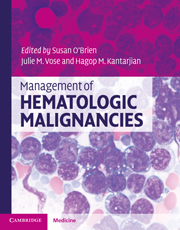Book contents
- Frontmatter
- Contents
- List of contributors
- 1 Molecular pathology of leukemia
- 2 Management of acute myeloid leukemia
- 3 Treatment of acute lymphoblastic leukemia (ALL) in adults
- 4 Chronic myeloid leukemia
- 5 Chronic lymphocytic leukemia/small lymphocytic lymphoma
- 6 Myelodysplastic syndromes (MDS)
- 7 Hairy cell leukemia
- 8 Acute promyelocytic leukemia: pathophysiology and clinical results update
- 9 Myeloproliferative neoplasms
- 10 Monoclonal gammopathy of undetermined significance, smoldering multiple myeloma, and multiple myeloma
- 11 Amyloidosis and other rare plasma cell dyscrasias
- 12 Waldenstrom's macroglobulinemia/lymphoplasmacytic lymphoma
- 13 WHO classification of lymphomas
- 14 Molecular pathology of lymphoma
- 15 International staging and response criteria for lymphomas
- 16 Treatment approach to diffuse large B-cell lymphomas
- 17 Mantle cell lymphoma
- 18 Follicular lymphomas
- 19 Hodgkin lymphoma: epidemiology, diagnosis, and treatment
- 20 Treatment approaches to MALT/marginal zone lymphoma
- 21 Peripheral T-cell lymphomas
- 22 Mycosis fungoides and Sézary syndrome
- 23 Central nervous system lymphoma
- 24 HIV-related lymphomas
- 25 Lymphoblastic lymphoma
- 26 Burkitt lymphoma
- Index
- References
20 - Treatment approaches to MALT/marginal zone lymphoma
Published online by Cambridge University Press: 10 January 2011
- Frontmatter
- Contents
- List of contributors
- 1 Molecular pathology of leukemia
- 2 Management of acute myeloid leukemia
- 3 Treatment of acute lymphoblastic leukemia (ALL) in adults
- 4 Chronic myeloid leukemia
- 5 Chronic lymphocytic leukemia/small lymphocytic lymphoma
- 6 Myelodysplastic syndromes (MDS)
- 7 Hairy cell leukemia
- 8 Acute promyelocytic leukemia: pathophysiology and clinical results update
- 9 Myeloproliferative neoplasms
- 10 Monoclonal gammopathy of undetermined significance, smoldering multiple myeloma, and multiple myeloma
- 11 Amyloidosis and other rare plasma cell dyscrasias
- 12 Waldenstrom's macroglobulinemia/lymphoplasmacytic lymphoma
- 13 WHO classification of lymphomas
- 14 Molecular pathology of lymphoma
- 15 International staging and response criteria for lymphomas
- 16 Treatment approach to diffuse large B-cell lymphomas
- 17 Mantle cell lymphoma
- 18 Follicular lymphomas
- 19 Hodgkin lymphoma: epidemiology, diagnosis, and treatment
- 20 Treatment approaches to MALT/marginal zone lymphoma
- 21 Peripheral T-cell lymphomas
- 22 Mycosis fungoides and Sézary syndrome
- 23 Central nervous system lymphoma
- 24 HIV-related lymphomas
- 25 Lymphoblastic lymphoma
- 26 Burkitt lymphoma
- Index
- References
Summary
Introduction
Marginal zone lymphoma (MZL) is a distinct subtype of non-Hodgkin lymphoma that has been recognized by Revised European–American Lymphoma (REAL) and World Health Organization (WHO) classifications. They have distinct morphologic and immunophenotypic features and a variable clinical course. This entity was traditionally designated as monocytoid B-cell lymphoma.
MZL is subdivided into three categories:
Extranodal MZL (EMZL) arises from mucosa-associated lymphoid tissue (MALT) identified by WHO classification as EMZL of MALT type;
Primary nodal MZL (PNMZL). By definition, in the WHO classification the term “nodal MZL” is used to define those cases primarily involving lymph nodes, and it excludes any case with prior or concurrent localization in an extranodal site except bone marrow, spleen, or liver; and
Splenic B-cell MZL (SMZL).
NMZL displays no appreciable differences in its histologic, cytologic, architectural, or phenotypic characteristics from those of EMZL. Consequently, it has been debated whether MZL with primary nodal involvement has to be considered a distinct disease or merely represents disseminated EMZL of MALT type. Therefore, the REAL classifications included MZL cases with primary lymph node involvement in a provisional category. Recently, Nathwani and colleagues identified several distinct clinical features for nodal and extranodal MZL. From the clinical behavior, NMZL seems to behave more like a low-grade follicular or small lymphocytic lymphoma unlike EMZL. This suggests biologic differences between EMZL and NMZL. The WHO classification recognized NMZL as a distinct disease that must be distinguished from EMZL of MALT-type with lymph node involvement and from other small B-cell non-Hodgkin lymphomas.
- Type
- Chapter
- Information
- Management of Hematologic Malignancies , pp. 404 - 409Publisher: Cambridge University PressPrint publication year: 2010

